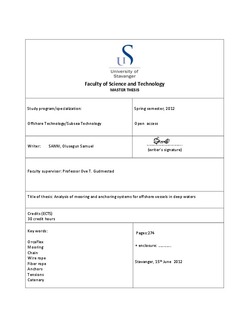| dc.description.abstract | This thesis is centered on the study and comparison of different mooring/anchoring systems for offshore vessels in deep waters. FPSO’s (Floating, Production, Storage and Offloading platforms), Light Weight Intervention vessels (LWI); Semi-submersible platforms and Mobile Offshore Drilling Units (MODU) make use of efficient mooring/anchoring systems to provide a connection between the floating vessel and the sea bed. If a good mooring/anchoring system is not in place, the offshore vessel can drift off location and consequently cause damage to the vessel, riser, drill pipe and other associated equipment, thereby, compromising the safety of the asset and offshore personnel. Safety of the mooring/anchoring system is essential in order to guarantee successful marine operations.
It is pertinent to have a strong mooring/anchoring system in order to secure the vessel against environmental forces and unplanned impact. As offshore technology is moving into deeper and deeper waters, there is an increasing challenge in the design of mooring/anchoring systems for offshore vessels. New technology, concepts, materials and sophisticated models showcasing the interaction between vessels and environment have been introduced. In this thesis, an investigation of the design and characteristics of different mooring/anchoring systems was carried out.
The major tasks carried out in this thesis are listed below:
Review of different mooring and anchoring systems for offshore vessels.
Use of OrcaFlex software to perform dynamic analysis of different mooring lines to determine the design criteria for a range of mooring/anchoring systems for different offshore vessels.
Performing a SWOT analysis of the mooring line materials.
Calculating different forces and tensions on the mooring lines based on the prevailing environmental conditions in deep waters.
The write-up begins with a review of different mooring and anchoring systems for offshore vessels followed by a SWOT (Strength, Weakness, Opportunities and Threats) analysis of different mooring line materials. A review of the regulations and standards governing the design and installation of mooring systems for offshore applications in different environments was also carried out.
Different combination of mooring lines were used in this analysis to secure the vessel in position and the tensions obtained across the arc length of each mooring line are presented in the results. Three mooring
line configuration cases were analyzed in this thesis. In the three cases, the offshore vessel is moored with eight symmetric mooring lines spaced 45° apart. The mooring lines configuration is Chain-Fiber rope–Chain in Case 1, Wire rope-Chain in Case 2, and Chain-Wire rope-Chain in case 3. The mooring geometry for all the cases is a catenary mooring system. The simulation uses regular waves acting on the vessel for the duration of 115 seconds. The mooring system employs a turret, located at the vessel’s moonpool. Since all mooring lines are connected to the turret, the vessel is free to rotate about the turret-wellhead axis and head into oncoming seas, regardless of direction. Thrusters are provided at the bow and stern to assist in maintaining a desired heading. The chain table connecting the mooring line to the turret is above the waterline. The wave theory used in the analysis is Dean Stream. The vessel used for the modelling is 103m long and weighs 8800 tonnes.
From the analysis carried out, it was observed that the maximum tension occurs at the turret end of the mooring lines. This is as a result of the vessel motions induced by environmental forces. The tensions obtained in Case 3 are quite high when compared to case1 and case 2, but are still within acceptable limits as they are less than the minimum breaking loads of the mooring line materials used. It was also observed that Chain impose an enormous weight on the mooring line compared to fiber ropes consequently resulting to increased tension in the lines. The use of synthetic fiber rope in the configuration reduced the mooring weight and increases flexibility, thereby reducing the mooring line tensions. The advantages of each mooring/anchoring system are optimized while dispelling their disadvantages. Recommendations as regards the selection of mooring/anchoring systems for different offshore vessels operating in different environments are presented in this report. The results of the dynamic analysis can be used to determine the design criteria for a range of mooring/anchoring systems for different offshore vessels. | nb_NO |

